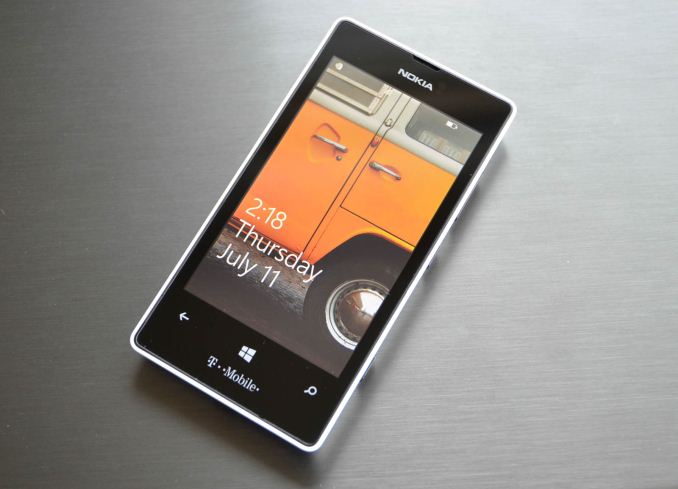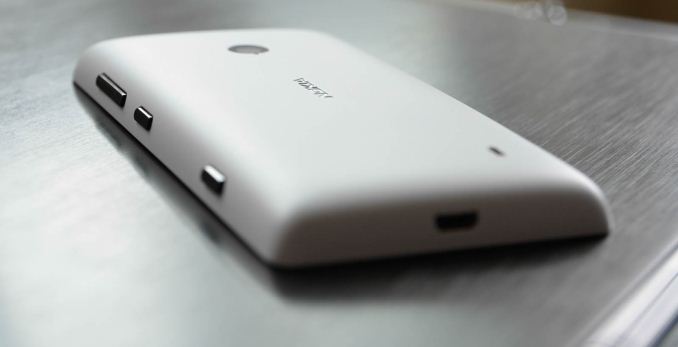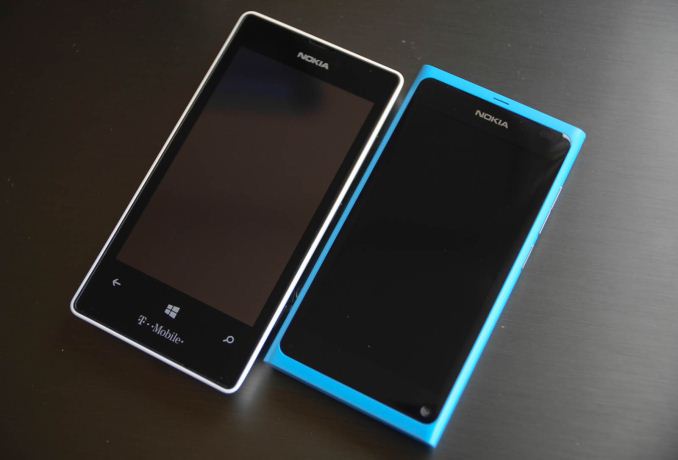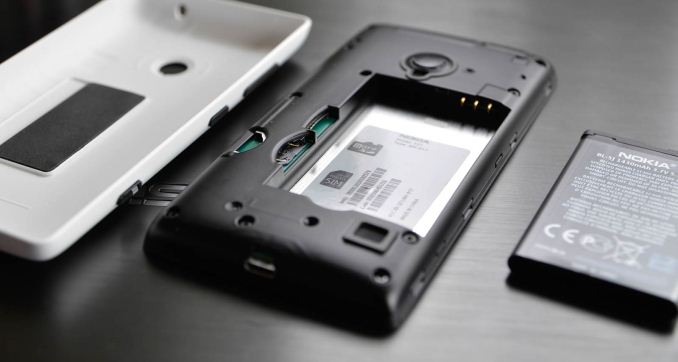Nokia Lumia 521: Quality Smartphone on an Extreme Budget
by Vivek Gowri on August 8, 2013 1:08 AM EST- Posted in
- Smartphones
- Nokia
- Mobile
- windows phone 8
- Lumia 520
- Lumia 521

Microsoft is in a difficult place with regards to the smartphone market. After delivering a very innovative interface and overall promising platform with Windows Phone 7 in late 2010, the platform stagnated, with mediocre hardware, slow updates, and not much progress in terms of sales. Bringing Nokia on board in 2011 gave Windows Phone a bit of a boost, particularly after the Windows Phone 8 launch with the success of the Lumia 920, but it’s still hard on a lot of levels to recommend a high-end Windows Phone versus the price-competitive iPhone and Android equivalents. But where I’ve long felt that Windows Phone devices make sense is with lower-end hardware.
And in that context, the Nokia Lumia 521 is very interesting. It’s the T-Mobile US version of the Lumia 520, and ships with AWS HSPA+ for just $129 sans contract or subsidy. It’s nearly identical to the 520 save for very minor dimensional differences and T-Mobile branding. AT&T gets the 520 in its original form as part of their GoPhone prepaid lineup for $99.99, no contract. The specsheet reads pretty respectably given the budget—Qualcomm’s MSM8227 SoC with dual-core Krait at 1GHz clocks, Adreno 305 graphics, 512MB RAM, 8GB of onboard NAND plus a micro SD slot, a 4” WVGA IPS panel, and a 5MP camera with an f/2.4 lens. And of course, this being Nokia, you’re assured of a pretty decent design and build. Nokia has always excelled at building durable, inexpensive handsets that didn’t feel cheap, which is one of the things that has propelled them to success in developing markets.
Microsoft’s insistence on keeping user experience consistent between devices as much as possible has led to some budget WP handsets that have been nearly as good as their more expensive brethren, so the potential has always been there, but this is the first time we’ve seen a Windows handset release at the floor-sweeper price point. So naturally, the Lumia 521 is interesting. The promise of a real smartphone at legitimately accessible price points, without the need to tie yourself into a contract or binding agreement of any kind, is fantastic. Tied in with T-Mobile’s BYOD-friendly no contract plans, this is actually a pretty credible handset for the tight of budget. AT&T’s $99 520 is even more ridiculous considering it doesn’t even break the century bill mark.
The only real difference between the 520 and 521 externally is the latter being 4.1mm taller in order to fit the T-Mobile logo at the bottom of the front face (124.0mm for the 521 versus 119.9mm for the international and AT&T versions of the 520). Beyond that, they share the same width, thickness, overall design and construction, and specs.
| Physical Comparison | ||||
| Nokia Lumia 521 | Nokia Lumia 520 | Nokia Lumia 920 | HTC 8X (International) | |
| Height | 124.0 mm (4.88") | 119.9 mm (4.72") | 130.3 mm (5.13") | 132.35 mm (5.21") |
| Width | 64.0 mm (2.52") | 64.0 mm (2.52") | 70.8 mm (2.79") | 66.2 mm (2.61") |
| Depth | 9.9 mm (0.39") | 9.9 mm (0.39") | 10.7 mm (0.42") | 10.12 mm (0.4") |
| Weight | 124 g (4.37 oz) | 124 g (4.37 oz) | 185 g (6.53 oz) | 130 g (4.59 oz) |
| CPU | 1 GHz MSM8227 (Dual Core Krait) | 1 GHz MSM8227 (Dual Core Krait) | 1.5 GHz Qualcomm MSM8960 (Dual Core Krait) | 1.5 GHz Qualcomm MSM8260A (Dual Core Krait) |
| GPU | Adreno 305 | Adreno 305 | Adreno 225 | Adreno 225 |
| RAM | 512 MB LPDDR2 | 512 MB LPDDR2 | 1 GB LPDDR2 | 1 GB LPDDR2 |
| NAND | 8 GB NAND with microSD slot | 8 GB NAND with with microSD slot | 32 GB NAND | 16 GB NAND |
| Camera | 5.0 MP, f/2.4 lens | 5.0 MP, f/2.4 lens | 8.7 MP, dual LED Flash + 1.3 MP front facing | 8 MP, LED Flash + 2.1 MP front facing |
| Screen | 4" 800x480 LED backlit IPS LCD | 4" 800x480 LED backlit IPS LCD | 4.5" 1280 x 768 IPS | 4.3" 1280 x 720 SLCD2 |
| Battery | Removable 5.29 Whr | Removable 5.29 Whr | Internal 7.4 Whr | Internal 6.8 Whr |
The 521 speclist hits a few major points that I’d consider pretty important in delivering a satisfactory mobile experience—IPS display, fast lens, a reasonably powerful SoC, expandable storage (in lieu of a sizeable amount of onboard NAND). Notable omissions include DC-HSPA+, a front-facing camera, a flash module, NFC, and wireless charging, but on paper it would seem that Nokia didn’t cut too many corners in their pursuit of a bargain smartphone.
The 521 is a good looking phone, with a wraparound battery cover that fits around the main body of the phone. Conceptually, it’s pretty similar to how the HTC 8X is put together, except that the entire thing is meant to come apart, giving users access to the battery as well as the micro SIM and micro SD card slots. Nokia has used this construction before with the 820 and 620, so it was no surprise to see it on the 520 and 521. The design language is very Nokia, with an organically contoured back and an elegant simplicity to the overall aesthetic. It manages to be understated without feeling plain, which Nokia has gotten very good at. It’s really not much of a question, but Nokia’s team of designers and engineers is truly world class—Nokia is the only company with the hardware level design chops to match Apple (though recently, HTC and Microsoft have shown promise as well).
In hand feel is actually really great—the 521 isn’t the thinnest handset in the world, but the 4” display gives it a very compact frame that’s a nice change from the 4.5-5” flagships of late. The ergonomics of the curved back are good, the phone just fits into your hand very well. The phone is light, but not unnaturally so—at 125g, it’s pretty reasonable for the size. It’s a bit odd to look at the 521 next to the brick-like Lumia 920, which has a 4.5” display and weighs a kind of ridiculous 185g; there’s very little family resemblance between the two. (It’s actually even more shocking to look at the 920 versus the svelteness of the same design language on the Lumia 800 and MeeGo-based N9, but that’s a different matter.)
The battery cover is a matte polycarbonate shell, in this case white. The 520 battery cover is offered with five different color shells—the classic Nokia cyan, yellow, red, black, and white—though due to the height difference, those shells won’t fit the 521 (I was heartbroken when I discovered this). There has been no word on any colored shells being offered for the 521 thus far, so I wouldn’t hold my breath.
The shell has the glossy black buttons attached to it, laid out in the traditional Lumia style of volume, power, and camera all on the left side of the handset. I’ve actually never really liked the setup in the past, because the flush chrome buttons on the side of the Lumia 800 and 900 were easy to mix up on accident. This got fixed to some degree with the 920, which added more space between the buttons, but the 521 goes a step further with generously-sized buttons that stick out from the sides by about a millimeter. It’s very easy to grab the right one by feel, and the buttons actuate with a positive click. There’s more travel to the buttons, which is nice and refreshingly old-school. The camera button, particularly, is awesome—it’s rare to find good two-stage camera buttons these days; this is probably the best I’ve seen in a couple of years. It sticks out a bit further than the other buttons and offers good feedback for both clicks.
The battery cover peels off the back of the phone pretty easily, exposing the sparse guts of the phone. There’s a hole in the shell for the camera lens, with some rubber padding in various places (around the camera module, speaker, and battery) to quell vibrations and offer a bit of protection. The interior of the phone is shockingly plain, with nary an extra screw, sticker, or plastic feature in sight. Penny pinching also probably led to the odd SIM-card insertion method—it isn’t spring loaded (neither is the microSD card slot), so you need to push the SIM card out from the plastic cutout. It’s not a problem, but it’s just evident that places like this are where every last cent had to be saved to hit the $129 price point.
Overall, the design is very pleasant. It’s clearly not high-end hardware, but it doesn’t try to be. It’s very solidly a budget handset, but a few cuts above what you get from Huawei and the like at this price point. This is Nokia at its best—focusing their hardware prowess on quality devices that don’t break the bank. The smartphone is a niche that has yet to be fully tapped in the emerging world, and offering a compelling handset like the 520 is key to Nokia’s future.




















116 Comments
View All Comments
Death666Angel - Thursday, August 8, 2013 - link
Huh, wasn't even aware of this phone. That's pretty good value for 140€. If my wife didn't have a Chinese phone since Christmas, I'd get her one of these.Gunbuster - Thursday, August 8, 2013 - link
I love this little phone. Having jumped on the deal at HSN for $80 I could destroy this phone 6 times over and still be ahead of buying a "high end" handset.You get 90% the capabilities of better phones at a price that is over 80% lower.
kmmatney - Thursday, August 8, 2013 - link
Can you use the AT&T GoPhone version with a normal regular AT&T plan? I'm tempted to sell my 4S 32GB before before the new iPhones come out, and use this for a while.thesavvymage - Thursday, August 8, 2013 - link
yeah you just pop in the SIM and it will work since it is compatible with AT&T's frequenciesImpulses - Friday, August 9, 2013 - link
At one point in time AT&T actually flagged GoPhone IMEIs and wouldn't let you use them with pre-paid plans tho, this was a few years ago, no clue if it's still in practice.jabber - Thursday, August 8, 2013 - link
Must admit at 1:1 the pics from the 520/521 look better than the pics taken with the Nexus 4 at 1:1VivekGowri - Thursday, August 8, 2013 - link
Yeah, I wouldn't disagree with that statement.Azurael - Friday, August 9, 2013 - link
The Nexus 4's camera is notoriously bad though. I don't know what LG were thinking! It's the only thing that's even giving me thoughts about upgrading to one of this year's latest and greatest handsets. Certainly not the 400+ PPI I can't discern displays or swanky new SoCs (which are only marginally faster than the S4 Pro in the N4 but driving 1920x1080)Then I remind myself that ALL mobile cameras, regardless of how 'good' they look AS mobile cameras - Nokia Pureview being a possible excepetion - are dreadful compared to the cheapest 1/2.3" sensor-equipped compact cameras, let alone anything better with a larger sensor. In fact, when I did have a phone with a better camera (One X), I didn't use it any more than I do with the terrible camera in the N4 now.
ljlego - Thursday, August 8, 2013 - link
"Far too often, you see important functions and options pushed into random corners of the interface, buried deep in some menu."That's a pretty bold claim that I have never experienced, personally. Could you maybe provide an example of when you've found this?
Collin5 - Thursday, August 8, 2013 - link
@VivekA well done review! It is balanced and it includes a lot of useful information not found anywhere else. Thank you!
However, I also feel there are a few statements, related to multitasking and overall performance, which paint a picture with too broad a brush. Nothing critical or wrong, but something you may want to look into for future reviews of WP devices:
1)
"Multitasking in Windows Phone has never really sat well with me, because it’s not really multitasking in the traditional sense—the need to completely close and rehydrate tasks makes resuming applications exceedingly slow."
On my Lumia 520 app switching occurs instantaneously most of the time. Only when I open more apps than the device can fit into RAM, is the least frequently used app completely closed out (tombstoned). Only when switching back to a tombstoned app does the rehydration process kick in (which I agree is too lengthy). However, even the Lumia 520 can simultaneously cache two or three apps in memory, which is enough to get through most multitasking scenarios without tombstoning occurring.
Saying that "the need to completely close and rehydrate" is too much of a blanket statement. That need only exists in very specific circumstances, which some may encounter only very rarely (depending on how people use their device).
2)
"...but in day to day use, it mostly makes itself felt in slower application loading and multitasking/task switching, which is also related to having just 512MB RAM instead of the 1GB of the 920."
This could be understood to imply that having less RAM negatively impacts the time it takes to load apps AND the time it takes to task-switch between them, which is false. Having less RAM has no affect on app load times. Having less RAM also has no direct impact on the time it takes to switch between apps. Having less RAM only has an indirect affect on task-switching in the way I already mentioned... RAM capacity determines how soon apps are tombstoned. That is all. Both app load times and rehydration (basically the same thing) are directly impacted by the slower CPU however.
Certainly we can argue that the probability of a task requiring rehydration is greater on a 512 MB device, but that is what I would expect an article on Anandtech to explicitly state, instead of attributing app load performance directly to RAM capacity ;-)